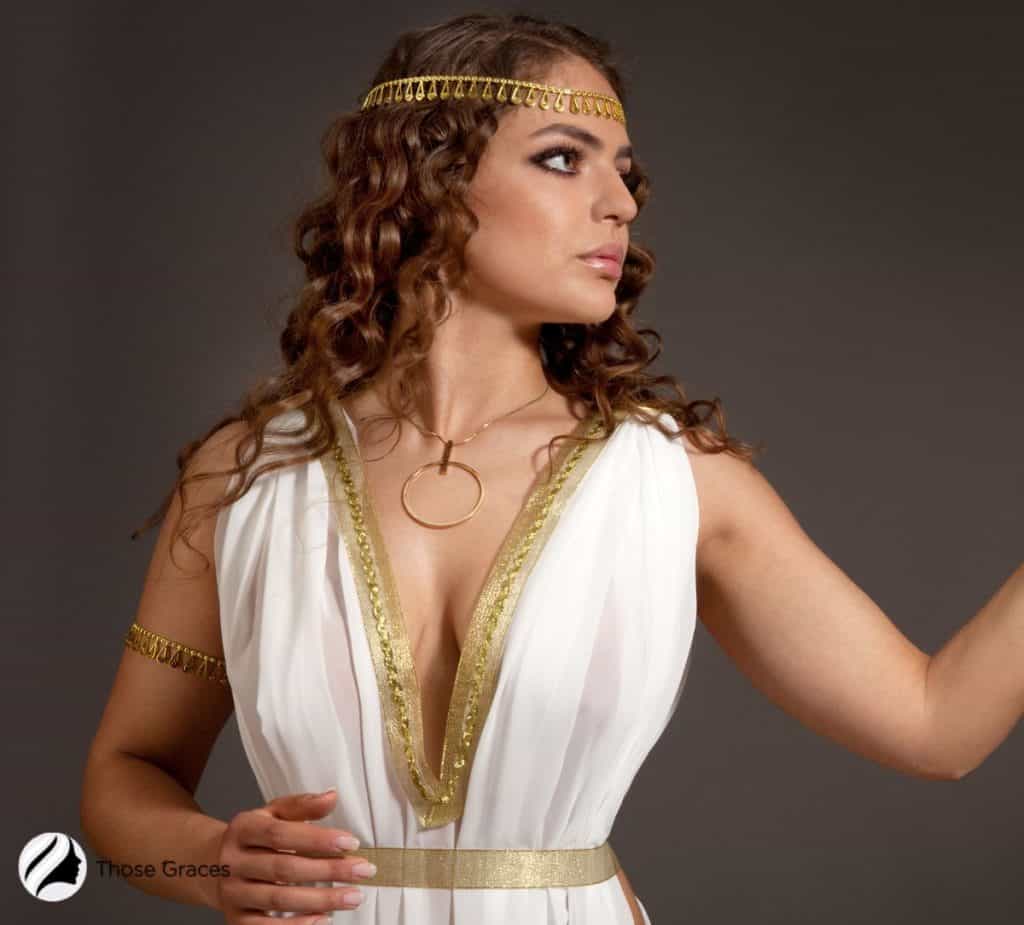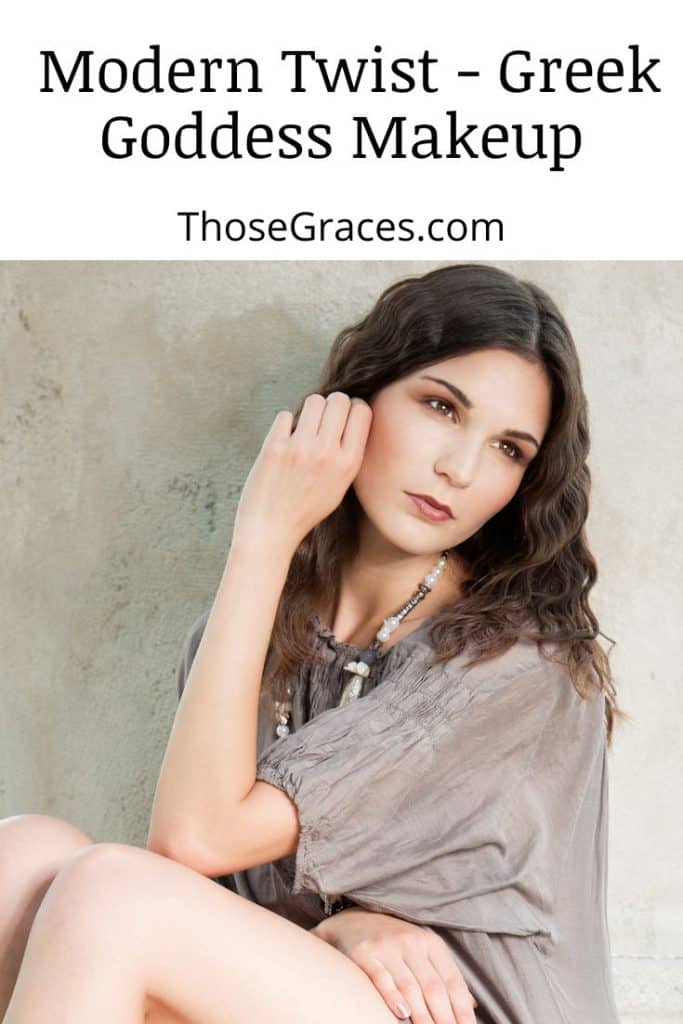Hey there, fellow beauty enthusiasts! Are you looking for a new makeup look to channel your inner goddess? Look no further than the Greek goddess makeup trend.
Inspired by the beauty and grace of ancient Greek goddesses, this makeup style features ethereal and luminous skin, bold brows, and striking eye makeup.
Whether you’re attending a special event or want to feel like a goddess in your everyday life, this makeup look will surely make you feel confident and empowered.
So, grab your brushes, and let’s get ready to channel your inner Aphrodite!
Table of Contents
Key Takeaways
- Divine Elegance! ✨ Greek Goddess makeup is all about a fresh, ethereal glow that captures the beauty and grace of ancient mythology.
- Heavenly Highlights! ☀️ Emphasize your natural features with luminous, sun-kissed skin and a touch of shimmer to bring out your inner deity.
- Olympian Eyes! 🌿 Enhance your gaze with soft, earthy tones, and don’t forget a hint of eyeliner to create an enchanting, otherworldly allure.
Modern Twist – Greek Goddess Makeup
No need to read all the history below if you’re not interested! We reference some of the histories in this guide.

The modern Greek goddess makeup and fashion look are popular for brides. With good reason! It’s a beautiful, ethereal look – and pairs well with the Grecian-style flowing wedding dress trend.
While the face was kept pretty natural in ancient Greece, the ‘Greek goddess’ makeup look is more glamorous, glowing, and quite heavier by comparison.
However, the modern goddess look is not completely divorced from Grecian culture. Many elements of the Greek goddess look are historically accurate – including the popularity of gold accessories, the sultry eye, the toga-style dress, and the long, decorated flowing hair. Think of it as an ancient Greek-inspired look with a modern twist.
Dressing up for Halloween or a costume party? It’s good to know your fancy dress costume is inspired by ancient Greek makeup and fashion.
However, this Greek goddess look has a definite modern twist. No need to go for the classic Grecian unibrow, and avoid using poisonous ingredients like white lead on your skin! Huge no-no!
Base: Dewy, Flawless, & Glowing Complexion
Use a luminous primer to prep your skin to glow like a goddess.
For a flawless-looking complexion, opt for a high-coverage dewy-satin finish foundation. While ancient Grecians loved the fair look, unless you’re completely committed to the ancient look, use a shade that matches your skin instead. Conceal any imperfections and dark circles for a healthy, glamorous look.
Eyes: Sultry Black & Gold Lids
For a sultry look, do as the Greeks do (or did) and apply black kohl and eyeshadow close to the eyes.
Don’t go overboard – too much black can be too harsh. Amp the look up a bit (in an ode to the ancient Greek elite’s appreciation of gold) with some gold eyeshadow. Pack on plenty of your favorite mascara (and fake lashes) to balance out the eyes.
Face: Glowing & Sculpted Cheekbones
While ancient Greeks kept the face pretty natural, the goddess makeup look is enhanced with a healthy dose of highlighter.
A gold shade on the cheeks will tie in beautifully with the eyeshadow and act as a nod to the importance of gold in ancient Greece. Otherwise, a champagne or white color works well too. Apply to the top of the cheekbones, the inner corners of the eye, the brow bone, down the nose, and on the cupid’s bow for an ultra-ethereal glow.
The Grecians liked to stay super pale and kept their face as natural as possible. However, a bit of bronzer and contour can give a glamorous modern twist to the Greek look. Don’t be shy with the bronzer (especially if you are also self-tanned); the warm bronze shade will tie in nicely with the gold on the eyes and cheeks!
Lips: Neutral, Natural Shades
When lip paint eventually caught on with the ancient Greeks, they kept the lips looking natural. Stick with a subtle pink or light nude to balance out the glow and sultry eyes.
Going for a fancy dress look? Apply gold highlight to the center of your lips for an even greater luminous glow.
If you enjoyed our articles on makeup looks, be sure to also check out our pieces on flapper makeup ideas and 90s grunge makeup for even more inspiration.
Ancient Greece-Inspired Clothing & Hair For Fancy Dress
Dressing as a Greek goddess for Halloween or a party?
Ancient Greeks mainly wore tunics (similar to togas) or long flowing dresses. Opt for a boho style, long, flowing white maxi dress to get this look. Waist emphasis with a belt (in a gold or white shade) is flattering on most body shapes.
On a budget, or just getting ready at the last minute? Grab a white bed sheet and tie it around your body for a quick Grecian-inspired outfit.
Long, curly hair was in fashion in ancient Greece, which complements this makeup look well. While blonde hair was highly coveted then, this look will work with any hair color. Add accessories like a headband or leaf hair clips (the Greeks did accessorize their hair) – keep their gold for extra historical accuracy!
Check out this amazing video tutorial:
Historically Accurate – The Real Ancient Greek Look
Makeup Trends In Ancient Greece
Women at the time were expected to look pure and modest.1 As a result, Grecian women opted for a more natural-looking face (except for some heavier eye makeup).
Because women were generally excluded from the academic and intellectual world, men wrote most of the information about makeup. And they wrote about it a lot! References to cosmetics pop up in tons of recovered ancient Greek materials – including poetry and letters.2
The general attitude of men towards makeup was strongly negative at the time.2 The use of cosmetics was widely criticized and satirized. In certain areas, such as Sparta, women wore no makeup.
The later Romans took inspiration from both the natural look of the Greeks and the more dramatic trends from Cleopatra’s Egypt. Ultimately, the Romans met somewhere in the middle between these two styles.1
Face: Pale Skin Was Achieved With Lead
Pale skin was in vogue for the ancient Greeks. It signified purity and was a symbol of wealth.3 If your skin was pale, you didn’t need to spend all day enduring hard labor in the sun.2
Women in ancient Greece achieved the pale look with white lead, chalk, kaolin, ceruse, and plaster materials.2 Interestingly, Plato denounced these ingredients as harmful (ahead of his time)!2 White lead is a by-product of silver. Silver was produced in abundance in ancient Athens – possibly explaining why white lead was the ingredient of choice to whiten the face.2
Although lead is obviously harmful in its purest form, there’s some evidence that the ancient Greeks (and Egyptians) were able to synthesize lead in their cosmetics to make it safer chemically.4 This interesting piece of cosmetic history highlights the intelligence of the people living in these ancient civilizations.
Beetroot, red wine, and aromatic resin were popular cosmetic ingredients.5 Olive oil was abundant in ancient Greece, and women made good use of it. It was especially popular in skincare – acting as both a moisturizer and skin cleanser.5
Eyes: The Unibrow Look
Women mixed ground charcoal and olive oil to create eye shadow. A dark eye look was in fashion – soot and kohl were applied to the eyebrows and lids.5
The unibrow trend is possibly the biggest difference in beauty standards between the ancient Greek time period and today.5 The dark powders applied to the lids and brows were also used in the middle of the brow to create the conjoined brow look.
Lips: Lip Tint Eventually Became Popular
Lipstick was worn (for the most part) only by ladies of the night. Due to the stigma around such work, the ancient Greeks regulated the use of lipstick.
However, a lip tint eventually became common among higher-class Grecians. This lip tint was made from better ingredients than the lipstick of the lower classes. However, it still contained dangerous ingredients like vermilion.
Here’s another video tutorial:
Clothing & Accessories In Ancient Greece
Men and women wore long, loosely draped tunics suitable for the warm climate.6 They held their tunics in place with broaches and pins. Women also wore basic, sleeveless dresses called ‘peplos.’6 The only embellishment was a belt placed at the empire line for some waist emphasis.
While richer Grecians could afford expensive fabrics like imported silk and cotton, most had to make do spinning their wool or linen at home.
Uncovered gold bracelets from the 4th and 5th centuries lend some credence to the stereotypical gold embellishment dress associated with this era.6 Gold was popular then because it was so rare in Greece. Another potent symbol of wealth, gold was highly valuable and imported from Egypt or Asia.6 Thin sheets of gold were shaped into wreaths and belts, especially for burial.6
Here’s a video if you want to know the fashion in Ancient Greece:
“Beauty is in the eye of the beholder.”
Ancient Greek Proverb.
Hair In Ancient Greece
Olive oil was also used in hair care as a conditioner for softer hair. While female slaves had short hair, the trend among free women was to keep it long. Hairstyles indicated marital status – single women left their hair free and loose, then tied it in a bun once they married.5
Women with straight hair curled it. In line with the modern-day stereotype, ancient Grecians loved hair accessories. Hairpins, scarves, jeweled combs, and diadems were common.5
Blonde hair was considered beautiful in ancient Greece. Women added vinegar to their hair in the sun to help lighten it.5
Women wore hats outside in an attempt to avoid tanning, but a lot of ladies pulled their hair through the hat to expose it to the sun.5 It’s even suspected that some women applied urine to their hair because it’s known for its bleaching abilities! 5
Check out this video:
What are the key features of Greek goddess makeup?
Can I wear Greek goddess makeup for everyday looks, or is it just for special occasions?
What are some tips for making Greek goddess makeup last all day or night?
Conclusion
In conclusion, Greek goddess makeup is a great way to channel your inner divinity and create a flawless look. Whether you’re aiming to embody the elegance of Aphrodite or the power of Athena, there are many tips and tricks to help you achieve your desired look.
With a little practice and creativity, you can unleash your inner goddess and rule the beauty world!

Resources
1. Croy A. Terrible and Toxic Makeup [Internet]. Google Books. Gareth Stevens Publishing LLLP; 2018 [cited 2023 Mar 21]. Available from: https://books.google.ie/books?id=pWpiDwAAQBAJ&dq
2. Eldridge L. Face Paint: The Story of Makeup [Internet]. Google Books. Abrams; 2015 [cited 2023 Mar 21]. Available from: https://books.google.ie/books?id=LpplCgAAQBAJ&printsec=frontcover&dq=Face+Paint:+The+Story+of+Makeup&hl=en&sa=X&ved=0ahUKEwi16qeKwpriAhUURhUIHYd0Cm4Q6AEIKTAA#v=onepage&q=Face%20Paint%3A%20The%20Story%20of%20Makeup&f=false
3. Draelos ZD. Cosmetic Dermatology: Products and Procedures [Internet]. Google Books. John Wiley & Sons; 2015 [cited 2023 Mar 21]. Available from: https://books.google.ie/books?id=D2a-CgAAQBAJ&printsec=frontcover&dq=cosmetic+dermatology+products+and+procedures&hl=en&sa=X&ved=0ahUKEwjipv3BydffAhUBThUIHSzUBP8Q6AEIKjAA#v=onepage&q=cosmetic%20dermatology%20products%20and%20procedures&f=false
4. Beck L, Caffy I, Delqué-Količ E, Moreau C, Dumoulin J-P, Perron M, et al. Absolute dating of lead carbonates in ancient cosmetics by radiocarbon. Communications Chemistry. 2018;1.
5. Chrystal P. Women in Ancient Greece [Internet]. Google Books. Fonthill Media; 2017 [cited 2023 Mar 21]. Available from: https://books.google.ie/books?id=fjMqDwAAQBAJ&printsec=frontcover&dq=Women+in+Ancient+Greece&hl=en&sa=X&ved=0ahUKEwiauLOE2dffAhU4RxUIHRcdD6UQ6AEIMTAB#v=onepage&q&f=false
6. Tames R. Ancient Greece [Internet]. Google Books. Rosen Pub.; 2009 [cited 2023 Mar 21]. Available from: https://books.google.ie/books?id=VwgnGHQqXn0C&printsec=frontcover&dq=ancient+greece+richard+tames&hl=en&sa=X&ved=0ahUKEwjy8–o1dffAhVNThUIHQ2_BI0Q6AEIKjAA#v=onepage&q&f=false


